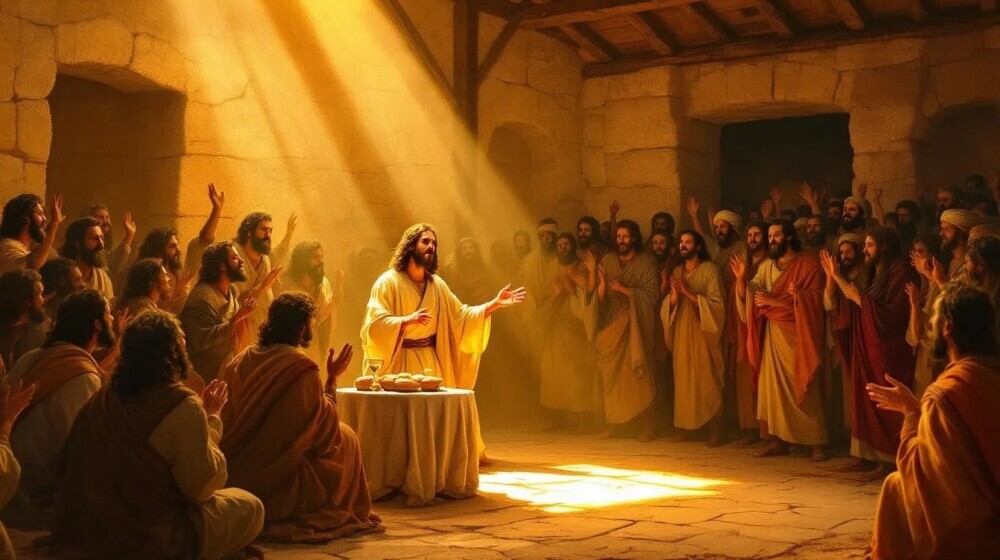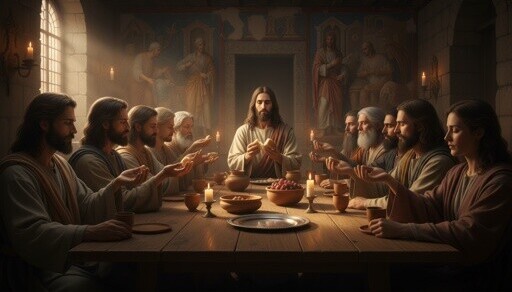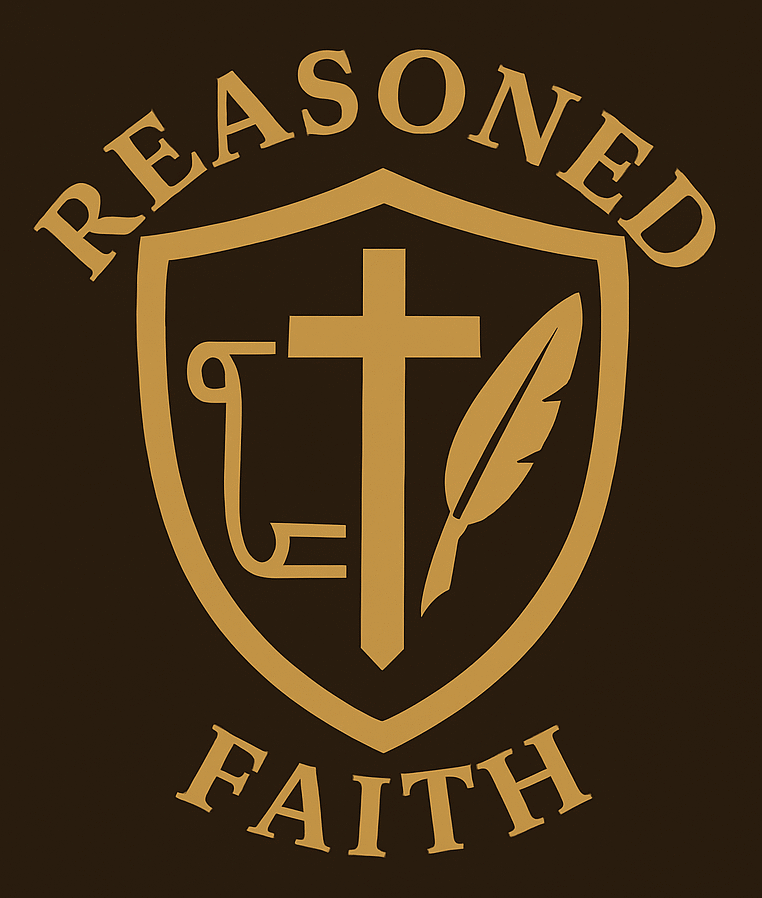
Few passages in Scripture have sparked more debate than John 6, where Jesus declares that His followers must eat His flesh and drink His blood to have eternal life. Many modern readers say He spoke symbolically. But when we look closely—at the context, His own words, and how those taught by the Apostles understood them—it becomes clear that Jesus meant exactly what He said.
Setting the Scene: From Loaves to Life
John 6:31–59 records what’s often called the Bread of Life Discourse, a pivotal moment in the Gospel. The setting is Capernaum, shortly after the miracle of the loaves and fishes. The crowd, still amazed, seeks another sign. “Our fathers ate the manna in the desert,” they remind Him (v. 31), hoping for more free bread.
But Jesus redirects them. He tells them not to work for perishable food, but for the food that endures to eternal life (v. 27). St. Augustine noted that the crowd “stopped in the mere excitement of being satiated.” They wanted full stomachs, not transformed souls.
Jesus begins to reveal something greater: “It was not Moses who gave you the bread from heaven; my Father gives you the true bread from heaven” (v. 32). Here, the conversation shifts from earthly to divine, from manna to Himself.

“I Am the Bread of Life”
When Jesus says, “I am the bread of life” (v. 35), He’s not offering poetry; He’s making a radical claim about His identity. Those who come to Him “shall not hunger,” He says—not because they’ll never eat again, but because they’ll find in Him the fulfillment of every spiritual hunger.
In these first verses, Jesus uses symbolic language—coming, believing, receiving—to describe faith. But then, the tone changes. The metaphor gives way to a concrete reality.
“The Bread That I Will Give Is My Flesh”
The turning point arrives in verse 51:
“The bread that I will give is my flesh, for the life of the world.”
The crowd immediately grasps how shocking this sounds. “How can this man give us his flesh to eat?” (v. 52). If Jesus were only speaking figuratively, this would have been the perfect time to clarify. Instead, He intensifies His words:
“Amen, amen, I say to you, unless you eat the flesh of the Son of Man and drink His blood, you have no life in you.
Whoever eats my flesh and drinks my blood has eternal life, and I will raise him up on the last day.” (vv. 53–54)
The Greek verb used here, trogo, means “to gnaw” or “to chew”—a deliberately earthy word that drives home physical reality. Six times in these verses Jesus repeats the command to eat His flesh and drink His blood. The repetition is intentional. He’s not speaking symbolically; He’s driving home a literal truth.
And the reaction? Many disciples murmur that this saying is “hard” (v. 60). So hard, in fact, that “many of His disciples drew back and no longer walked with Him” (v. 66). If Jesus only meant “believe in Me,” why would they leave? Belief was nothing new. They walked away because they understood Him literally—and He let them go.

The Early Church Understood It Literally
The Christians who lived closest to the time of the Apostles had no doubt about what Jesus meant.
- St. Ignatius of Antioch (A.D. 107) called the Eucharist “the flesh of our Savior Jesus Christ.”
- St. Justin Martyr wrote around A.D. 155 that the food we call the Eucharist “is not common bread or common drink; but… the flesh and blood of that Jesus who was made flesh.”
- St. Irenaeus, disciple of Polycarp (who was taught by St. John himself), said that the Eucharist “is no longer common bread but the Eucharist, consisting of two realities, earthly and heavenly.”
These witnesses show the belief wasn’t invented later; it was there from the beginning. The Church simply preserved what she received.
Faith vs. Fleshly Thinking
Some point to verse 63—“It is the Spirit that gives life; the flesh profits nothing”—as proof Jesus was speaking metaphorically. But that interpretation doesn’t fit the context. Jesus isn’t dismissing His own flesh; after all, His flesh is what He gives “for the life of the world.”
He’s contrasting spiritual understanding with carnal thinking—the same misunderstanding that caused the crowd to stumble. The Spirit reveals divine mysteries that human reasoning alone cannot grasp. As Augustine explained, “The words that I have spoken to you are spirit and life—not because they are allegorical, but because they are to be understood spiritually.”
Faith, then, is the key. When many turned away, Peter stayed—not because he understood, but because he trusted:
“Lord, to whom shall we go? You have the words of eternal life.” (v. 68)
Why the Symbolic View Falls Short
The “symbolic only” reading of John 6 collapses under its own weight. Symbols don’t cause scandal, and metaphors don’t drive disciples away. Jesus used figures of speech often—and when people misunderstood, He clarified (as with Nicodemus and being “born again,” or the woman at the well and “living water”). But here, He doesn’t explain; He reinforces.
Even the grammar of the text refuses symbolism. “My flesh is true food and my blood is true drink” (v. 55). The Greek word alethes means real, genuine—not metaphorical. If He meant “represents,” He chose the wrong word.
The crowd’s shock, the disciples’ departure, the apostles’ steadfast faith, and the early Church’s unanimous belief all point to the same conclusion: Jesus meant what He said.
From the Upper Room to the Altar
John 6 finds its fulfillment at the Last Supper: “This is My Body… This is My Blood” (Luke 22:19–20). The words of institution are not a change of topic but the completion of the promise made in Capernaum.
When the priest consecrates the bread and wine at Mass, Catholics believe—just as the first Christians did—that they become the Body and Blood of Christ. The outward appearances remain, but the substance changes. This mystery, called transubstantiation, is the Church’s way of describing what Jesus declared long ago: the bread is no longer mere bread; it is Him.

A Promise That Endures
In John 6, Jesus offers Himself as the living bread come down from heaven. The manna sustained Israel for a day; the Eucharist sustains the Church for eternity. Through every age and culture, the same Jesus invites us to partake of His divine life.
When we approach the altar, we echo Peter’s faith-filled confession: “Lord, to whom shall we go?” The Eucharist is not a symbol of Christ—it is Christ, the Bread of Life, given so that we “may have life, and have it abundantly.”
Further Reading
This post contains affiliate links. If you make a purchase through these links, I may earn a commission at no extra cost to you. As an Amazon Associate I earn from qualifying purchases.

This reflection beautifully captures both the power and the tension in John 6. What moves me most is how Jesus didn’t soften His words even when people started leaving. That moment separates followers from fans — those who want truth from those who only want comfort. I’ve always seen the Bread of Life discourse as a test of faith’s depth, not its understanding. Like Peter, we often stay not because we fully grasp it, but because we trust the One who said it.
I also appreciate how you tied the early Church Fathers into the conversation. Too often, people treat history as optional when interpreting Scripture, but their witness anchors faith in continuity, not confusion. It reminds us that truth doesn’t evolve; our comprehension of it deepens.
As the old African proverb says, “A tree is known by its fruit.” In the same way, faith is known by its endurance. The Bread of Life continues to nourish those who believe—not because it’s easy to accept, but because it’s eternally true.
—John
Thank you for such a thoughtful reflection. You’re exactly right — Jesus doesn’t backpedal or rephrase in John 6, even when His own followers walk away. That moment forces a choice, just as it did in the first century: do we follow Christ only when His teaching fits our expectations, or do we trust Him even when the mystery stretches us? Peter’s response captures the heart of discipleship so beautifully: “Lord, to whom shall we go?” We stay not because we understand everything, but because we know the One who speaks.
I’m also glad you highlighted the role of the early Church. Their witness keeps us rooted in how Christians actually lived and believed from the beginning, especially about the Eucharist. It’s not just theology on paper — it’s a faith that endured, bore fruit, and nourished saints across generations. Like that proverb you quoted, the fruit of faith is found in its perseverance. The Bread of Life isn’t merely explained; it’s received, trusted, and lived. Thanks again for sharing such a rich insight.
Thank you for sharing such a passionate and well-researched perspective. I’ve read through your post carefully, and while I appreciate the depth of your conviction, I personally lean toward a symbolic understanding of Jesus’ words in John 6. Throughout Scripture, Jesus often used metaphors to reveal spiritual truths: ‘I am the door,’ ‘I am the vine,’ ‘living water’—and I believe ‘I am the bread of life’ follows that same pattern.
When Jesus speaks of eating His flesh and drinking His blood, I see it as a vivid call to internalize His life, teachings, and sacrifice; not a literal consumption. Verse 63 stands out to me: ‘It is the Spirit who gives life; the flesh profits nothing.’ That, to me, points to a spiritual interpretation rather than a physical one.
I also wonder: if Jesus truly meant His words to be taken literally, why didn’t He clarify at the Last Supper when He said, ‘Do this in remembrance of Me’? Wouldn’t that have been the moment to explain the transformation if it were physical?
I say this not to debate, but to reflect. I value these discussions because they help us all wrestle with Scripture more deeply. Thank you again for opening this space for honest engagement.
Thank you so much for your thoughtful comment and for engaging so carefully with my article. I truly appreciate your honesty and reflective spirit — your perspective helps deepen the conversation.
You’re right that Jesus often used metaphors — “I am the door,” “I am the vine,” “living water.” In those cases, Scripture itself makes the symbolism clear or provides an explanation so the listener understands. But in John 6, Jesus’ approach is different. When His audience takes Him literally and struggles to accept it, He doesn’t correct them or soften His words — He repeats them, even as many disciples walk away. That silence in the face of misunderstanding suggests He meant what He said, rather than a metaphor to be re-explained.
Verse 63 — “It is the Spirit who gives life; the flesh profits nothing” — is often used to argue for a symbolic meaning, but even several respected non-Catholic scholars (including David Guzik, D. A. Carson, and Leon Morris) note that “the flesh” here refers to human reasoning apart from the Spirit, not a denial of Jesus’ own flesh, which He gives “for the life of the world.”
Even the early disciples of the apostles — St. Ignatius of Antioch (taught by John), St. Justin Martyr, and St. Irenaeus (disciple of Polycarp, who learned from John) — all affirmed that Jesus’ words about eating His flesh and drinking His blood were to be understood literally, not symbolically.
Thank you again for your kind engagement. Conversations like this help all of us reflect more deeply on Scripture and the mystery of Christ’s words.